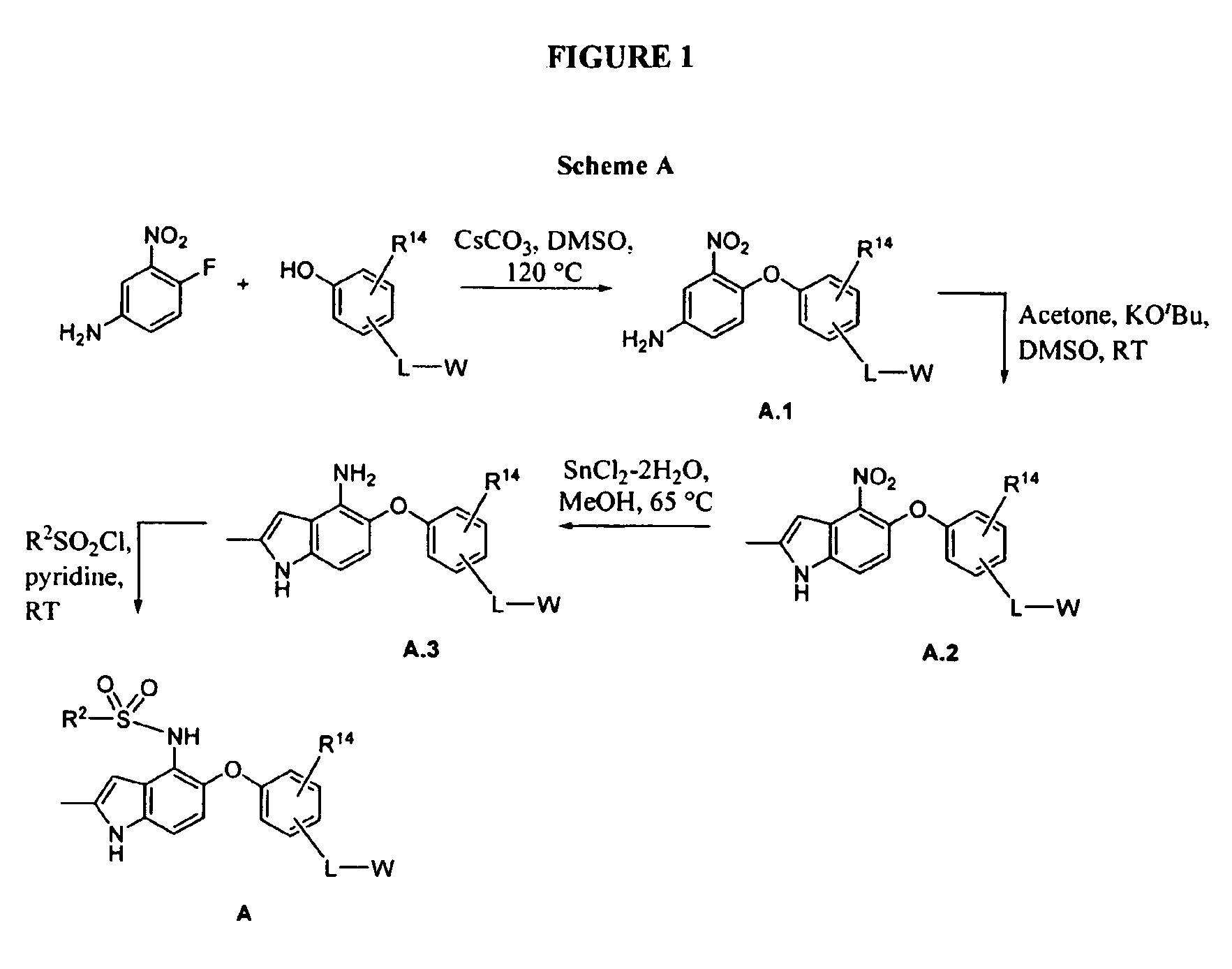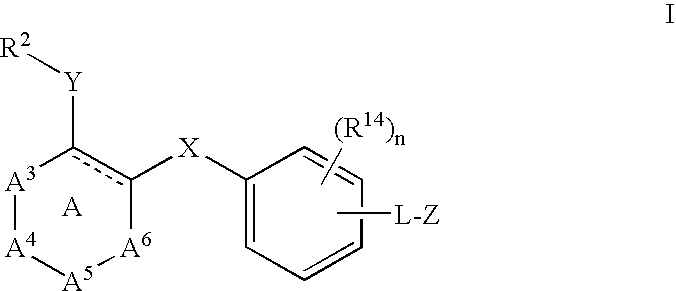Compounds and methods useful for treating asthma and allergic inflammation
a technology for applied in the field of compounds and methods useful for treating asthma and allergic inflammation, can solve problems such as pain, function loss, and tissue or organ damag
- Summary
- Abstract
- Description
- Claims
- Application Information
AI Technical Summary
Benefits of technology
Problems solved by technology
Method used
Image
Examples
example 1
7.1. Example 1
[0260]This example illustrates the preparation of 2-(4-(4-(2,4-dichlorophenylsulfonamido)-2-methyl-1H-indol-5-yloxy)-3-methoxyphenyl)acetic acid (1).
[0261]2-(4-(4-Amino-2-nitrophenoxy)-3-methoxyphenyl)acetic acid (1.1). A mixture of 4-fluoro-3-nitroaniline (3.45 g, 22.1 mmol), 4-hydroxy-3-methoxyphenylacetic acid (4.03 g, 22.1 mmol) and cesium carbonate (18.0 g, 55.3 mmol) in methylsulfoxide (40 mL) was heated to 120° C. (external temperature, oil bath) overnight. After 16 h the reaction was poured into water and the pH adjusted to 1H NMR (400 MHz) (CDCl3) δ 7.27 (d, J=8.4 Hz, 1H); 6.93 (s, 1H); 6.84-6.79 (m, 4H); 5.90 (br s, 2H); 3.85 (s, 31H); 3.63 (s, 21H) ppm.
[0262]2-(3-Methoxy-4-(2-methyl-4-nitro-1H-indol-5-yloxy)phenyl)acetic acid (1.2). The reaction was carried out in a three-necked flask fitted with an overhead stirrer. To a room temperature solution of 1.1 (5.00 g, 15.7 mmol) and acetone (3.46 mL, 47.1 mmol) dissolved in methylsulfoxide (80 mL) was added solid...
example 2
7.2. Example 2
[0266]This example illustrates the preparation of 2-(4-(3-Chloro-4-(2,4-dichlorophenylsulfonamido)-2-methyl-1H-indol-5-yloxy)-3-methoxyphenyl)acetic acid (2).
[0267]2-(4-(3-Chloro-4-(2,4-dichlorophenylsulfonamido)-2-methyl-1H-indol-5-yloxy)-3-methoxyphenyl)acetic acid (2). A room temperature solution of 1 (14 mg, 0.026 mmol) and N-chlorosuccinimide (4 mg, 0.029 mmol) dissolved in N,N-dimethylformamide (1 mL) was stirred for 40 min., after which time HPLC indicated no 1 remained. The reaction was partitioned between ethyl acetate and 10% sodium thiosulfate aqueous solution. The organic separation was washed twice with water then brine. The organic layer was stirred over magnesium sulfate, filtered and the filtrate concentrated in vacuo on a rotary evaporator to afford a colorless solid. The product was isolated by semi-preparative reversed phase HPLC to afford a colorless solid. LC-MS ESI (neg.) m / z: 567.1 (M−H). 1H NMR (400 MHz) (d6-DMSO) δ 11.41 (s, 1H); 9.66 (br s, 1H...
example 3
7.3. Example 3
[0268]This example illustrates the preparation of 2-(4-(4-(2,4-dichlorophenylsulfonamido)-1,2-dimethyl-1H-indol-5-yloxy)-3-methoxyphenyl)acetic acid (3).
[0269]Ethyl 2-(3-methoxy-4-(2-methyl-4-nitro-1H-indol-5-yloxy)phenyl)acetate (3.1). A solution of 1.2 (1.65 g, 4.63 mmol) in ethanol (20 mL) with several drops of concentrated sulfuric acid was heated to reflux overnight. After 16 h, HPLC indicated that no 1.2 remained and the ethanol was removed in vacuo on a rotary evaporator. The concentrate was partitioned between ethyl acetate and saturated aqueous sodium bicarbonate solution. The separated organic layer was washed with water then brine, stirred over magnesium sulfate, filtered and the filtrate concentrated in vacuo on a rotary evaporator to afford a dark oil. The desired product was isolated by trituration of the residue with ethyl acetate to yield the desired product as an orange solid. The filtrate from trituration was chromatographed on silica gel, eluting wit...
PUM
| Property | Measurement | Unit |
|---|---|---|
| pH | aaaaa | aaaaa |
| temperature | aaaaa | aaaaa |
| temperature | aaaaa | aaaaa |
Abstract
Description
Claims
Application Information
 Login to View More
Login to View More - R&D
- Intellectual Property
- Life Sciences
- Materials
- Tech Scout
- Unparalleled Data Quality
- Higher Quality Content
- 60% Fewer Hallucinations
Browse by: Latest US Patents, China's latest patents, Technical Efficacy Thesaurus, Application Domain, Technology Topic, Popular Technical Reports.
© 2025 PatSnap. All rights reserved.Legal|Privacy policy|Modern Slavery Act Transparency Statement|Sitemap|About US| Contact US: help@patsnap.com



